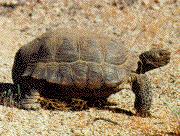

Common Names: Gopher
Tortoise
Genus: Gopherus
Species: agassizii

The Desert Tortoise can be found in the Mojave and Sonoran Deserts of southern California, two of North America's four deserts. They inhabit semi-arid grasslands, gravelly desert washes and sandy canyon bottoms below 3,500 ft.
The Desert Tortoises is a land dwelling turtle belonging to the Testudinidae family. The Desert Tortoise is also known as a gopher tortoise because it belongs to one of 4 species of the Gopherus genus.
Its front legs are muscular and flattened with long claws, and are very well adapted for digging deep burrows. Desert Tortoises can make hissing, popping, and poinking sounds, usually out of fear or distress. Its domed, brown shell (carapace) can grow to be 9-15 inches in length, 4-6 inches high, and the tortoise can weigh from 8 to 15 lbs. They usually live to be about 80 years, but some have been known to be a 100 years old.
Both sexes have an extension on the front of their lower shell called a gular horn. The horn is longer on the males and they will use them to upturn rival males. Males will fight each other whenever they meet. These fights usually end with the defeated male scurrying away. Males and females will share crevices and burrows to get out of the extreme heat of the day, but when they emerge, the males will again try to upturn each other.
To escape the heat of the summer and the cold of winter the desert tortoises live in burrows which they dig. Some of them can be three to six feet deep. They will spend November through February in a torpid state in their underground burrows. Some burrows have been used for over a hundred years. 95% of a tortoise's life is spent underground. Their most active time is in the spring when they will forage for herbs, grasses, new growth of cactus and annual flowers.
Desert Tortoises will develop a preference for certain plants, to which their digestive systems become accustomed. When forced to eat unfamiliar plants, their digestive tract need several months to become accustomed to them and be able to extract all available nutrients and water from them. Because they only have a few months in the spring to take in enough water to last them all year, destruction of their habitats and the plants in it can be fatal to the desert tortoise in the long run.
The Desert Tortoise will dig catch basins in the soil to catch the infrequent rain that falls. They remember where the basins are and return to them when it rains. Most of their water intake comes from moisture found in the grasses and wildflowers they eat in the spring. The tortoise has the ability to store about a quart of water in its bladder to be used when necessary. Adult Desert Tortoises can go for years without water.
The Desert Tortoise will mate anytime it is above the ground. The females can store sperm and will lay a clutch of 4-8 hard-shelled eggs in a nest dug near the burrow opening in May, June, and July . She can lay 2 to 3 clutches a year. The female will leave the nest and the eggs are then incubated by the warm soil. After 90 to 120 days the young tortoises hatch.
Only a few out of every hundred of the 2-3 inch hatchlings will make it to adulthood. Their shells stay soft for the first 5 years and they are preyed upon by coyotes, roadrunners, gila monsters, and ravens (Corvus corax). In some parts of the Mojave Desert ravens are responsible for the death of about 50% of the juvenile Desert Tortoises.
Another reason the Desert Tortoise population grows slowly is because they don't reproduce very fast. Females don't breed until they are 15 to 20 years old and then may only lay eggs if there is enough food available. Their birth intervals are 2-3 years.
It is unlawful to touch, harm, harass or collect a wild Desert Tortoise. Please keep your distance if you ever see a Desert Tortoise in the wild. When frightened they will empty their bladder as a defense mechanism, and the loss of water can be fatal to the tortoise. The Desert Tortoise is considered a "threatened" species under the California state Endangered Species Act in 1989 and the federal Endangered Species Act in 1990.
Illegal collection for the pet trade, destruction of their habitats by urban area expansion and by off-road vehicles, and increased predation by ravens are some of the factors contributing to the Desert Tortoise's decline. Several military bases there use the desert as a practice range, and people race off-road vehicles through it, destroying the forage plants and crushing vulnerable juvenile Desert Tortoises. The population of the Desert Tortoise in the Mojave Desert has gone down 90% since 1980.
Even though a desert looks empty and lifeless, it is filled with many species of animals, like the Desert Tortoise, who need our special consideration.
2001
Bibliography:
"Desert Tortoise", http://www.nps.gov/moja/planning/tort.htm, (Feb. 2001).
"Desert Tortoise", http://www.nps.gov/moja/mojaandt.htm, (Feb. 2001).
Betty Burge, A.R. Royo, "Desert Tortoise Wildlife Information - Desert USA", http://www.desertusa.com/june96/du_tort.html, (Feb. 2001).
"Desert Tortoise Information From the Desert Tortoise Preserve Committee", http://www.tortoise-tracks.org/gopherus.html, (Feb. 2001).